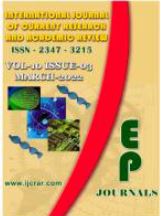Abstract Volume:10 Issue-3 Year-2022 Original Research Articles
 |
Online ISSN : 2347 - 3215 Issues : 12 per year Publisher : Excellent Publishers Email : editorijcret@gmail.com |
Sources of tolerance and reliable trait evaluation methods are crucial inbreeding for abiotic stress tolerance. Waterlogging is one of the most important abiotic stresses in high rainfall areas. Waterlogging tolerances have been reported in different plant species. However, the complexity of the trait makes it very difficult to evaluate, thus hard to breed for. A reliable screening method can make the breeding programme more successful. Plant breeding techniques, conventional or genetic engineering, might be an effective and economic way of developing crops to grow successfully in waterlogged condition. Marker assisted selection (MAS) is a new and more effective approach which can identify genomic regions of crops under stress. The discovery of comprehensive molecular linkage maps enables us to do the pyramiding of desirable traits to improve in waterlogging tolerance through MAS. However, because of genetic and environmental interaction, too many genes encoding a trait, and using undesirable populations, the mapping of QTL was hampered to ensure proper growth and yield under waterlogged conditions. Steady advances in the field of genomics and proteomics over the years will be helpful to increase the breeding programs which will help to accomplish a significant progress in the field crop variety development and also improvement in near future. Waterlogging response of soybean and major cereal crops, such as rice, wheat, barley, and maize and discovery of QTL related with tolerance of waterlogging, development of resistant variety, and in addition, future prospects have also been discussed.
How to cite this article:
Zeleke Keimeso. 2022. Review Article: Plant Breeding for Water Logging Resistance.Int.J.Curr.Res.Aca.Rev. 10(3): 93-104doi: https://doi.org/10.20546/ijcrar.2022.1003.010



Quick Navigation
- Print Article
- Full Text PDF
- How to Cite this Article
- on Google
- on Google Scholor
- Citation Alert By Google Scholar
